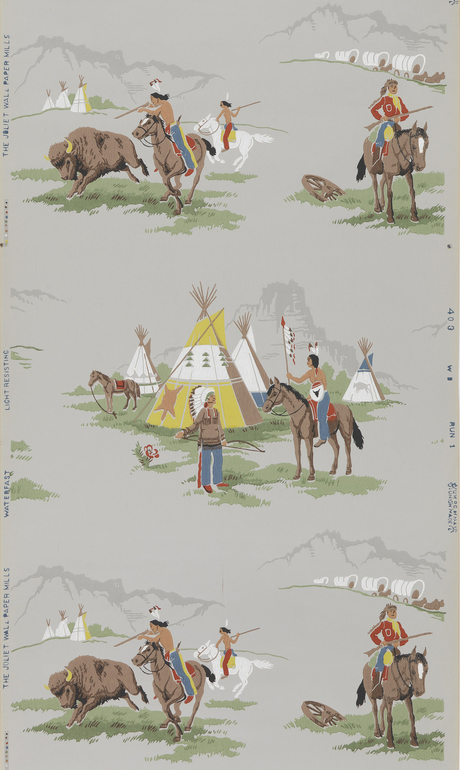Cowboys and Indians – that quintessential childhood game of midcentury suburbia – is here turned into a wallpaper destined for the rooms of young boys learning how to adhere to the famously rigid gender roles of the 1950s. Three little vignettes are machine printed in shades of yellow, green, red, brown and blue on a gray background. The vignettes depict scenes of Westward expansion on the Great Plains. The first shows two Native Americans conversing in front of a grouping of four teepees. One man sits atop a horse, holding a spear decorated with feathers and a shield with a buffalo’s head. The other stands on the ground, holding a large bow and wearing an elaborate feather headdress. The next vignette shows two more Native American men chasing down a buffalo on horseback, the teepee village now far in the background. The third vignette shows the lone cowboy of the paper. He’s a Daniel Boone type, dressed in a red button-down, blue jeans and a raccoon skin cap. He looks out over the landscape as a train of covered wagons passes behind him. The faint outlines of mountain ranges are visible in the background of all three scenes. For this wallcovering, at least, the cowboy and Indians seem content to keep to themselves, allowing each other to go about their business unmolested.
These rather generic images of the Wild West fit into a broader genre of “boy appropriate” wallpapers that were used to decorate children’s rooms starting in the mid twentieth century. Within the Cooper Hewitt’s collections are similar papers showing spaceships, car mechanics, hunting, fishing and even the Boy Scouts doing boy things. Though gender neutral nursery papers had been around since the late nineteenth century, older girls of the 1950s would have to content themselves with a nice floral wallpaper, as themed papers specifically for girls were not printed until the 1970s. This seemingly innocuous “Cowboy and Indian” wallpaper reveals the gender stereotypes of a generation. Boys should be encouraged to explore, build and provide. Girls like flowers that are pretty.
Anna Rasche is a student in the History of Decorative Arts & Design graduate Program at the Cooper Hewitt, and is a Master’s Fellow in the Wallcoverings Department.

2 thoughts on “No Girls Allowed”
dwain rogers on April 22, 2018 at 11:21 pm
had this on my wall in 1950 and would like to do a wall in my home again, where can i get this wallpaper?
Mike on May 20, 2023 at 2:42 pm
Found a vintage roll here https://www.mercari.com/us/item/m12018034894/?gbraid=0AAAAADR9UGcSkSqM8jrOpmXLH1W7hxjdz&gclsrc=aw.ds&&utm_source=google&utm_medium=cpc&utm_campaign=17490236309&utm_content=t0&adgroup=140710677514&network=g&device=m&merchant_id=126358573&product_id=m12018034894&product_id=1958682101990&gbraid=0AAAAADR9UGcSkSqM8jrOpmXLH1W7hxjdz&gclid=CjwKCAjw36GjBhAkEiwAKwIWyZvZ6poQYZylbJoy73lJtl1CvCYSJwHgBMb3udhD4rwPNEEsdlm_-RoC1LsQAvD_BwE